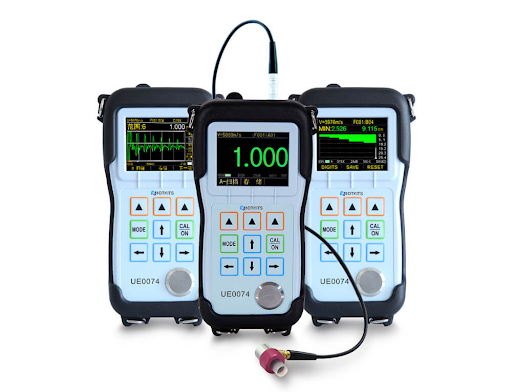When you’re tasked with inspecting materials without damaging them, ultrasonic thickness testing is one of the most reliable methods available. It allows you to evaluate wall thickness, detect wear, and maintain structural integrity—all without cutting, drilling, or dismantling anything.
But here’s the challenge: not all ultrasonic thickness testers are the same. If you’re working with painted or coated surfaces, the type of tester you choose can significantly impact accuracy and efficiency. In this article, you’ll learn how these devices work, how they differ, and which one fits your needs best.
Understanding the Basics of Ultrasonic Thickness Testing
Ultrasonic thickness testing works by sending high-frequency sound waves into a material and measuring the time it takes for the echo to return from the opposite surface. This time is then used to calculate the material’s thickness.
This method is widely used across industries—for example, in corrosion monitoring for pipelines, integrity checks on ship hulls, and inspections of pressure vessels and storage tanks. However, when a part is coated with paint, epoxy, or other protective layers, standard testers may not accurately isolate the base material’s thickness. That’s where the choice of equipment becomes critical.
Standard Testers: Suitable for Basic Jobs
How They Operate?
A standard ultrasonic thickness tester measures the full thickness—from the outer surface (including any coating) to the internal boundary. This means that unless you remove the paint or account for it manually, the reading will include both the base metal and the coating.
Where They Work Well?
If you’re inspecting unpainted or freshly manufactured parts, these devices are simple and effective. They’re affordable and widely used in applications where coatings aren’t a concern.
Limitations to Keep in Mind
However, the need to strip coatings or perform manual adjustments makes standard testers less ideal for in-service components. This process can be time-consuming and may damage surface finishes—especially if grinding or scraping is required to access bare metal.
Coating-Through Testers: Designed for Real-World Conditions
How They Function?
Coating-through ultrasonic thickness testers use a technique called dual-echo or echo-to-echo. This method allows the device to ignore the coating layer and calculate the true thickness of the base material by measuring only the time between two back-wall echoes.
Why You Might Prefer Them?
These testers give you accurate results on painted, coated, or scaled surfaces—without the need to strip anything. This not only speeds up your inspection process but also protects the integrity of the material being tested.
Potential Drawbacks
While they offer great benefits, coating-through models are generally more expensive. They may also require more setup and calibration time, especially if you’re dealing with a variety of surface conditions.
Comparison Summary: What Really Sets Them Apart
Here’s a simple overview to help you see the differences more clearly:
| Feature | Standard Tester | Coating-Through Tester |
| Coating Handling | Includes coating | Ignores coating |
| Accuracy on Painted Surfaces | Lower | Higher |
| Cost | Lower | Higher |
| Ideal Use | Clean/uncoated surfaces | Painted or coated surfaces |
| Inspection Speed | Slower (requires prep) | Faster (no prep needed) |
| Risk of Surface Damage | Yes | No |
Choosing the Right Tool for Your Inspection Tasks
The decision depends on your working environment and inspection goals.
- If you’re checking brand-new parts, or the surfaces are unpainted and easily accessible, a standard tester may be all you need.
- But if you regularly inspect pipelines, tanks, or equipment that’s been in use—especially those with coatings or corrosion layers—you’ll save time and avoid errors with a coating-through model.
Also, think long-term. If inspections are frequent, the higher initial investment in a coating-through tester could pay off in speed, accuracy, and labor savings.
Still not sure which model to choose? You can explore detailed product specs and get expert guidance at ndt-kits.com, a trusted provider of ultrasonic thickness testing equipment.
Don’t Forget Calibration and Upkeep
Regardless of the type you choose, every ultrasonic tester requires regular calibration. For coating-through models, you’ll often need specific calibration blocks that match the material and coating type. Skipping this step can result in inaccurate readings, even with advanced equipment.
Make sure you follow the manufacturer’s guidelines, and train your technicians to perform routine checks before each inspection.
Final Thoughts
Your choice between a standard and a coating-through ultrasonic thickness tester should be based on how and where you plan to use it. If coatings are part of your inspection reality—as they are in many industrial settings—a coating-through tester offers the accuracy and efficiency you need.
But even if you’re working with uncoated materials, don’t just look at the price tag. Consider the time, labor, and rework costs associated with each type of device. By choosing the right tester up front, you reduce the risk of measurement errors and ensure smoother, more reliable inspections.



